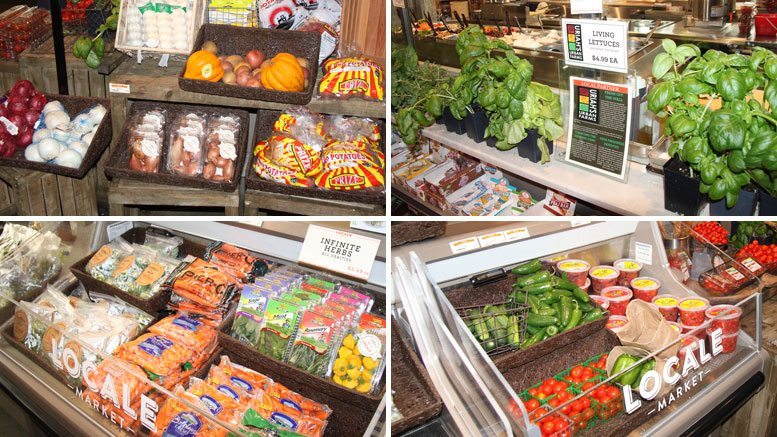Locale Market
July 1, 2017 | 5 min to read


Produce Is A Key Part Of This Tampa Bay Gourmet Marketplace
 The logo of Locale Market features a fish mounted on a weather vane with a carrot in its mouth. It’s symbolic of the importance of produce to the specialty grocery store. The market, which opened in December 2014, was created to be a unique culinary marketplace that sells fresh and artisanal foods.
The logo of Locale Market features a fish mounted on a weather vane with a carrot in its mouth. It’s symbolic of the importance of produce to the specialty grocery store. The market, which opened in December 2014, was created to be a unique culinary marketplace that sells fresh and artisanal foods.
Locale Market is located in downtown St. Petersburg, FL, in the Sundial Plaza shopping district. On the floor above the gourmet marketplace is the FarmTable Kitchen restaurant, a full-service restaurant offering casual gourmet dining with fresh seasonal and local ingredients.
While the store’s produce department is a comparatively small part of the 20,000-square-foot culinary operation, fresh produce is prominent and featured throughout. Produce is in every eating “station,” which offers foods, including pasta, sushi and meats. Store personnel make strings of vegetarian pasta from zucchini squash, a variety of fresh smoothies and fresh-made dressings.
The produce department supports the store’s other areas, as shoppers don’t restrict their visits to any single department and shop for accompanying items. “The produce department is crucial in this store,” says Mordechai Baron, culinary veteran and general manager. “To have those nutrients is important for peoples’ diets and well-being.”
The market carries approximately 65 produce items supplied by Sysco Corp.’s FreshPoint, Orlando, FL, as well as from local suppliers. To keep items fresh, the store doesn’t display product more than 24 hours. Older product is repurposed into other parts of the store or discarded.
The produce aisle is located in the center of the store, between the salad bar area and prepared meats. It includes baby carrots, cherry tomatoes, shallots, garlic, red, yellow and Spanish onions, peppers, potatoes, squash and herbs. The market repacks its produce into smaller, more convenient packages. As consumers enter the store, they will see a Fast & Fresh area for pizzas; to the right is a cheese and charcuterie section.
Produce Promotion
Cross-merchandising remains important for promoting produce throughout the store to provide shoppers meal ideas, says Baron. At the Sun & Moon Salutations vegetarian station, which offers fresh bowls, including acai, pockets and fresh fruit cups, apples and mangos are on the counter. Alongside it is a large display of watermelon, cantaloupe, apples, pears, bananas and mangos.
Trays of growing herbs and microgreens are situated on the cake and confectionery counter. At the grill, Vidalia onion burgers and sweet potato tots are offered among the varieties of hamburgers, including bison, lobster and salmon.
Locale Market’s staff show shoppers how to use produce and the store’s other foods. For example, they can show how to easily prepare herbs from scratch and how, when chopped nicely and grilled with fish, can enhance a protein’s natural flavor. “How can we offer a great dried steak or a brilliant duck confit without offering the greens?” asks Baron.
Shopper Education
Many viewing today’s food magazines or culinary offerings see art on a plate. “Some may say they could never produce that, but our job is to make it easy and available for consumers to know they can do it at home,” says Baron. “We are here to show them how they can embrace and enhance it, and go forward with these foods.”
That education includes a Shop with the Chef program to show how to properly host dinner parties. Baron uses such courses to help demystify the gourmet culinary experience for those who


“When one goes into a regular grocery market, they have only one station. With produce, we want them to see the flow in the market, giving them what they want and showing them what they need.”
That flow includes displaying produce items in other areas that shoppers not visiting the produce section might miss, such as the dragon fruit Baron recently introduced to a school group, or explaining the difference between green and white asparagus. “We want to utilize something outside of the box,” he says. The store makes its own juices, which include carrot and green juice consisting of kale, spinach and celery. It also juices its beets.
Baron tries to remain on the market floor at all times. “It’s our duty not to just help our guests purchase an item, but to help them understand the item, show them why they need it and how they can utilize it in more than one way,” he says.
The store tries to balance dry and fresh foods. “If you do it only one way, you get only one dimension,” says Baron. “In today’s culinary world, you have to have different dimensions to cross and try. We push the boundaries in our culinary creations.”
Local Focus
Partnerships with local growers are important at the chef-driven market. Brick Street Farms, which hydroponically grows red kitchen spinach and arrowhead spinach in shipping containers, is less than two miles from the market. At the end of July, the store planned a collaborative dinner featuring local foods and craft drinks sponsored by the grower and a local distillery.
The store sponsors monthly Local at Locale parties, showcasing food from the store’s food stations. Chefs develop dishes with local ingredients, such as corn and alligator meat. More than 400 people attend and sample the offerings in the Sundial courtyard in a block-like party. Nearly 500 people showed up for a low country boil.
Each month, a produce company will feature its products in the store. “Consumers like to support the local producers,” says Baron. “Local growers, they are the community. If we don’t support them, they won’t have anyone to service. It’s important we listen to what the consumers want and give them that. It’s also important for us to support the community itself.”
Signage displays the product’s origin and shows shoppers how to use the product. Living lettuces from local indoor growing partner Uriah’s Urban Farms, which grows herbs and leafy greens in Tampa, are displayed in front of the salad bar station.
In today’s diets, many people try to be healthy by eating protein and lessening their intake of starches. Produce provides nutrients to help balance what they’re eating, says Baron. A store chef will often want to develop recipes that can jump off the plate and are more than only lettuce and tomatoes. “People are often afraid to try something unfamiliar,” says Baron. “We need to introduce specialty greens and vegetables that you see in the market, but no one ever told you about or your mom didn’t include in meals. We need to educate consumers on how these are great products that you can get so much from.”
Booming Store Demographic
The store’s customers include a variety of people who reside in and around the thriving downtown center of St. Petersburg, FL. The college-aged crowd through retirees shop and dine at the market. Many living in area high rises trek to the market. Construction of new high rises should also increase traffic, says Baron. The area receives many visitors from across the Tampa Bay. Many who visit the local farmers market dine there. “Downtown St. Petersburg is booming,” says Baron.
A neighborhood of single family homes is within walking distance, so people wander in to have eating experiences. The shopping and restaurant entities are separate, but complement each other. Diners can shop the store’s many products and order food for dining in or takeout.
Locale Market is part of the San Francisco-based Mina Group restaurant management company, which has created 32 upscale restaurant concepts. The market was developed as a tribute to the friendship of James Beard Award-winning chef and founder Michael Mina and chef and author Don Pintabona.
Locale Market
179 2nd Ave., N
St. Petersburg, FL 33701
P: 727.523.6300
www.localegourmetmarket.com
Hours
Mon – Thur: 8 am – 9 pm
Fri – Sat 8 am – 10 pm
Sun 8 am – 9 pm
Article 16 of 16

